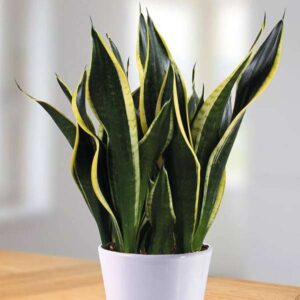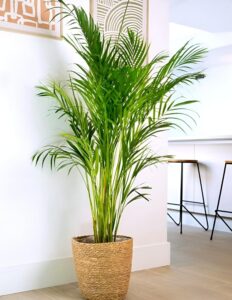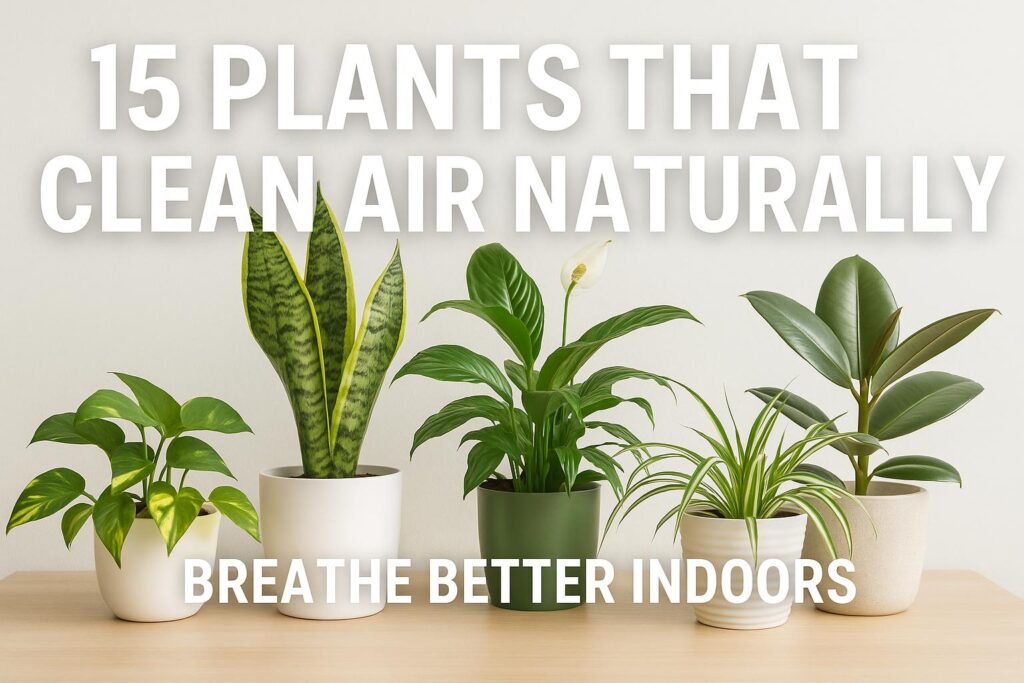15 Plants That Clean Air Naturally: Breathe Better Indoors
Introduction
In today’s world, we spend over 90% of our time indoors — surrounded by furniture, paint, electronics, and cleaning products that quietly release harmful pollutants into the air. These pollutants, like formaldehyde, benzene, and trichloroethylene, may cause headaches, allergies, or even long-term health issues. Fortunately, Mother Nature has a solution: air-purifying indoor plants.
NASA’s Clean Air Study proved that certain houseplants can filter out toxic chemicals and improve indoor air quality. These plants not only add a splash of green to your space but also work silently to detoxify the air around you. Whether you’re decorating your living room, bedroom, or office, adding a few of these green heroes can help you breathe easier and feel more refreshed.
In this guide, discover 15 of the best plants that clean air naturally — along with care tips to keep them thriving in your home.
Why Does Indoor Air Need Purifying?
Indoor air can be 2–5 times more polluted than outdoor air. Common culprits include:
- Volatile Organic Compounds (VOCs) from paints, glues, and cleaning supplies.
- Carbon monoxide from stoves and heating systems.
- Mold spores in humid areas.
- Dust and allergens from carpets and upholstery.
These toxins can cause fatigue, headaches, respiratory problems, and worsen conditions like asthma.
Top 15 Plants That Clean Air Naturally
1. Snake Plant (Sansevieria)
- Air benefits: Removes formaldehyde, xylene, benzene
- Care: Low light, water every 2–3 weeks
- Bonus: Converts CO₂ into oxygen at night

2. Spider Plant (Chlorophytum comosum)
- Air benefits: Absorbs carbon monoxide and formaldehyde
- Care: Indirect light, keep soil slightly moist
3. Peace Lily (Spathiphyllum)
- Air benefits: Filters ammonia, benzene, VOCs
- Care: Moderate light, water weekly
- Caution: Toxic to pets
4. Areca Palm (Dypsis lutescens)
- Air benefits: Humidifies and purifies air
- Care: Bright, indirect light; water regularly

5. Aloe Vera
- Air benefits: Removes benzene, formaldehyde
- Care: Bright sunlight, water when dry
- Bonus: Gel soothes burns
6. English Ivy (Hedera helix)
- Air benefits: Removes airborne mold and fecal particles
- Care: Bright light, keep soil moist
7. Bamboo Palm (Chamaedorea seifrizii)
- Air benefits: Filters out formaldehyde and trichloroethylene
- Care: Low light, water moderately
8. Rubber Plant (Ficus elastica)
- Air benefits: Absorbs airborne toxins
- Care: Medium light, water weekly

9. Boston Fern (Nephrolepis exaltata)
- Air benefits: Removes pollutants and adds humidity
- Care: Indirect light, keep soil damp
10. Golden Pothos (Epipremnum aureum)
- Air benefits: Removes benzene, carbon monoxide
- Care: Low light, minimal watering
11. Chinese Evergreen (Aglaonema)
- Air benefits: Cleans multiple VOCs
- Care: Low light, water occasionally
12. Philodendron
- Air benefits: Removes formaldehyde
- Care: Bright, indirect light; easy to grow
13. ZZ Plant (Zamioculcas zamiifolia)
- Air benefits: Filters toluene, xylene
- Care: Drought-tolerant, low light

14. Lady Palm (Rhapis excelsa)
- Air benefits: Removes ammonia and VOCs
- Care: Bright indirect light, moist soil
15. Dwarf Date Palm (Phoenix roebelenii)
- Air benefits: Filters xylene and other pollutants
- Care: Partial sun, well-drained soil
Benefits of Air-Purifying Plants
- Cleaner, toxin-free air
- Reduced stress and anxiety
- Improved sleep quality
- Better humidity levels
- Natural décor for your space
Tips to Maximize Their Effectiveness
- Use 1 plant per 100 sq. ft. for best air-purifying impact.
- Dust leaves weekly for clear pores and efficient filtering.
- Group plants together to increase humidity.
- Avoid overwatering to prevent root rot and mold.
Frequently Asked Questions
1. Do indoor plants really purify the air?
Yes, many indoor plants naturally remove toxins like formaldehyde, benzene, and carbon monoxide from the air, helping you breathe cleaner indoors.
2. Which indoor plant is best for air purification?
The Snake Plant, Peace Lily, and Spider Plant are among the best air-purifying plants for homes and offices.
3. How many plants do I need to purify a room?
Experts recommend at least 1 medium-sized plant per 100 square feet for noticeable air-purifying effects.
4. Are air-purifying plants safe for pets?
Some are pet-safe (e.g., Areca Palm, Spider Plant), while others like Peace Lily and Snake Plant can be toxic to pets. Always check before buying.
5. Can air-purifying plants grow in low light?
Yes, plants like Snake Plant, ZZ Plant, and Pothos thrive in low-light indoor conditions and still purify the air.
6. Do these plants require a lot of maintenance?
Most air-purifying plants are beginner-friendly and require minimal care — just indirect light, occasional watering, and proper drainage.
7. Can plants really replace an air purifier?
Plants help improve air quality naturally, but for severe pollution or allergies, they should complement—not replace—an air purifier.
8. Which NASA-approved plants clean the air?
NASA’s Clean Air Study highlighted plants like Peace Lily, Snake Plant, English Ivy, and Areca Palm as effective air purifiers.
9. Do plants remove mold and dust from the air?
Some plants (like English Ivy) can help reduce airborne mold, and their leaves trap dust, making them useful for cleaner indoor air.
10. What are the easiest air-purifying plants to grow indoors?
Pothos, Snake Plant, and Spider Plant are easy to grow, highly effective, and perfect for beginners.
Conclusion
Air-purifying plants are an easy, natural way to cleanse your indoor air while beautifying your space. Whether you’re aiming for a healthier home, better sleep, or just want to add some green charm, these 15 powerful plants can make a big difference. Choose a few that suit your home and lifestyle — and breathe in the freshness, naturally.

